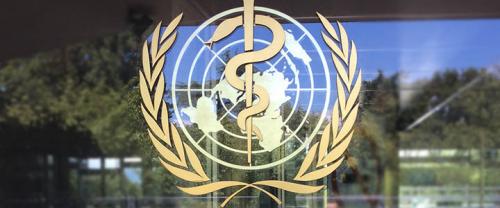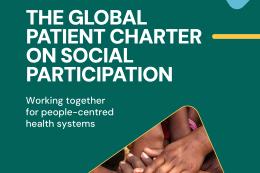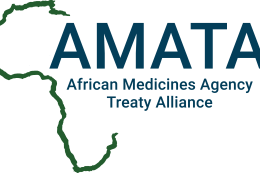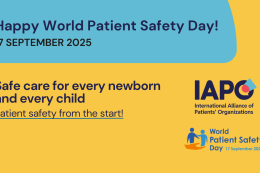Patient Organizations at the 72nd World Health Assembly
Monday, 15 April 2019

In the lead up to the 72nd World Health Assembly happening between 20 - 28 May, IAPO will be doing a series that aims is to provide insight into how the WHO works with patients’ organizatons and the benefits of these collaborations as well as how they are established.
This series aims to assist patients’ organizations to:
- Understand the role of WHO
- Understand why the WHA takes place
- Consider the potential benefits of working with WHO
- Identify who to work with in WHO
- Understand the different ways to engage with WHO
About WHO
WHO is the health agency of the United Nations (UN), based in Geneva, Switzerland. WHO was established on 7 April 1948, a date that is now celebrated as World Health Day. Over the last 60 years, WHO has been working towards its objective of “the attainment by all people of the highest possible level of health”. WHO is the decision-making body which defines global health issues and creates policies which impact on regional decision-making and national health systems around the world. WHO is an important partner for many patients’ organizations because of its pivotal role in global health.
What is the role of WHO?
The core functions of WHO are to:
- Provide leadership and engage in partnerships to address international health issues
- Support and promote health research and its dissemination
- Produce health guidelines and standards
- Develop ethical and evidence-based policy options
- Provide technical support to enable countries to address public health issues
- Monitor and assesses health trends
WHO forms policies which impact on health systems around the world. Through WHO’s coordination, national governments work together to address global health issues, including international responses to infectious diseases such as malaria, tuberculosis and HIV/AIDS. WHO promotes the use of evidence-based tools and standards to help countries define their health policies and supports research programmes to help identify public health priorities. It has supported a number of international campaigns, including efforts to reduce the burden of NCDs, as well as providing technical support to countries on such issues. WHO is also responsible for the World Health Report, a leading international publication on health, and the World Health Survey.
How is WHO structured and governed?
WHO’s membership is made up of 194 countries, known as Member States, and two Associate Members. They meet every year in May at the World Health Assembly (WHA), the decision-making body of WHO. WHO is overseen by a Director-General who is elected every five years by the Health Assembly. Their work is supported by the 34 Members of the Executive Board who are elected by the Health Assembly and meet twice a year in January and May. The main function of the Board is to put into effect the decisions and policies of the Health Assembly. WHO employs a secretariat of over 8,000 people from all over the world, who work for WHO in 147 country offices, six regional offices and at the headquarters in Geneva, Switzerland.
The World Health Assembly
The World Health Assembly (WHA) is the decision-making body of WHO and is attended by delegations from all WHO Member States. The WHA focuses on a specific health agenda prepared by the Executive Board and its main functions are to determine the policies of WHO, to appoint the Director-General, supervise financial policies, and review and approve the proposed programme budget. The WHA is held annually in Geneva, Switzerland.
Enhancing partnerships
WHO has a commitment to working collaboratively, stating that: “Only through new ways of working and innovative partnerships can we make a difference and achieve our goals.” WHO works with a range of partners, including UN agencies, donors, non-governmental organizations, WHO collaborating centres and the private sector, and it is under the category of non-governmental organizations that patients’ organizations are recognised (assuming that they are non-governmental).
The WHO’s Declaration of Alma-Ata in 1978 identified primary healthcare as the key to addressing global health needs through guiding values and principles. Principle IV of the WHO Alma-Ata Declaration states that: “The people have the right and duty to participate individually and collectively in the planning and implementation of their healthcare.
WHO and Patients’ Organizations
How can patients’ organizations benefit from working with WHO?
WHO’s pivotal role in global health, as well as its extensive expertise, makes it a powerful ally for patients’ organizations. By working in partnership with WHO, patients’ organizations can:
- Raise awareness of a health issue
- Provide and gain technical expertise in guidelines and practices
- Develop research statistics and an evidence-base to support advocacy campaigns
- Build understanding and support for a patient-centred approach to healthcare within WHO
Joint activities between patients’ organizations and WHO are wide and variable, ranging from gaining recognition for a global health issue to producing a joint publication at international level, to involvement in a prevention or treatment programme at country or regional level.
The recognition by WHO of a healthcare issue as global can be instrumental in gaining the visibility and support which your organization needs to achieve its mission. When a healthcare issue is recognised by WHO through the adoption of a resolution at the WHA, Member States have agreed to and made a commitment to this resolution. This can provide your organization with vital support where it is an issue of relevance to your organization’s mission. Your organization can stress to national governments commitments made at WHO and outline the invaluable contribution which you can bring to fulfilling these commitments and defining a national strategy.
Recent resolutions adopted on NCDs and viral hepatitis have created global recognition for these diseases and built momentum to help prevent and manage these diseases throughout the world. They have provided a platform for further engagement between WHO and Member States with patients’ organizations for joint action to tackle these issues.
What can WHO gain from working with patients’ organizations?
Patient experiences make an invaluable contribution to global policies and the implementation of these policies within countries. WHO can benefit from working with patients’ organizations in a number of ways, including:
- Ensuring that policies reflect patient and care giver needs, preferences and capabilities
- Filling the evidence gap on how health works best for people in middle- and low-income countries
- Advocating for WHO standards, e.g. the Patient Safety ‘Clean Your Hands’ campaign
- Identifying how to measure and monitor effective patient participation and engagement for health globally
- Utilising established networks and communication channels which have been created to engage all healthcare stakeholders and communities
How can patients’ organizations engage with WHO?
Patients’ organizations are an essential partner in ensuring that technical programmes, as well as policies, meet the needs of the people that they are intended to serve. Joint action can be extremely effective in:
- Generating and disseminating research
- Implementing best practice guidelines and checklists
- Creating ethical and evidence-based policy
- Building capacity to meet healthcare needs within countries
- Monitoring and assessing health trends
WHO has made a commitment to working with non-governmental organizations (NGOs), however, the civil society space is very crowded. In order to make your organization a key partner in WHO’s work, you need to demonstrate the value you can bring to WHO’s work.
Our relationship with WHO
IAPO has official relations with WHO, coordinated through their Patients for Patient Safety work. This grants us certain privileges including attending and making interventions at the WHO Executive Board Meetings and the World Health Assembly, as we did for the Regional Committee meetings in September and October. These meetings are attended by high level delegates from around the world, including Ministers of Health, WHO regional directors, as well as representatives from a range of non-state actors such as academics, philanthropists, industry representatives and civil society. It is therefore a key networking and advocacy opportunity.
It is likely that a Board Member and staff will attend some of the meetings, and we invite you to review the agenda and let us know if there are key issues that you are interested in.



